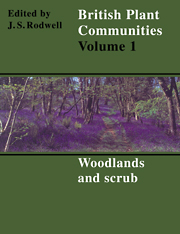Book contents
- Frontmatter
- Contents
- List of Figures
- Foreword
- Preface and Acknowledgements
- Preamble
- General Introduction
- Woodlands and Scrub
- Introduction to Woodlands and Scrub
- Key To Woodlands and Scrub
- Community Descriptions
- W1 Salix Cinerea-Galium Palustre woodland
- W2 Salix Cinerea-Betula Pubescens-Phragmites Australis Woodland
- W3 Salix Pentandra-Carex Rostrata Woodland
- W4 Betula Pubescens-Molinia Caerulea Woodland
- W5 Alnus Glutinosa-Carex Paniculata Woodland
- W6 Alnus Glutinosa-Urtica Jzozca Woodland
- W7 Ainus Glutinosa-Fraxinus Excelsior-Lysimachia Nemorum Woodland
- W8 Fraxinus Excelsior-Acer Campestre-Mercurialis Perennis Woodland
- W9 Fraxinus Excelsior-Sorbus Aucuparia-Mercurialis Perennis Woodland
- W10 Quereus Robur-Pteridium Aquilinum-Rubus Fruticosus Woodland
- W11 Quereus Petraea-Betula Pubescens-Oxalis Acetosella Woodland
- W12 Fagus Sylvatica-Mercurialis Perennis Woodland
- W13 Taxus Baccata Woodland
- W14 Fagus Sylvatica-Rubus Fruticosus Woodland
- W15 Fagus Sylvatica-Deschampsia Flexuosa Woodland
- W16 Quereus spp.-Betula spp.-Deschampsia Flexuosa Woodland
- W17 Quereus Petraea-Betula Pubescens-Dicranum Majus Woodland
- W18 Pinus Sylvestris-Hylocomium Splendens Woodland
- W19 Juniperus Communis Ssp. Communis-Oxalis Acetosella Woodland
- W20 Salix Lapponum-Luzula Sylvatica Scrub
- W21 Crataegus monogyna-Hedera helix scrub
- W22 Prunus Spinosa-Rubus Fruticosus Scrub
- W23 Ulex Europaeus-Rubus Fruticosus Scrub
- W24 Rubus Fruticosus-Holcus Lanatus Underscrub
- W25 Pteridium Aquilinum-Rubus Fruticosus Underscrub
- Index of Synonyms to Woodlands and Scrub
- Index of Species in Woodlands and Scrub
- Bibliography
W18 - Pinus Sylvestris-Hylocomium Splendens Woodland
Published online by Cambridge University Press: 04 July 2020
- Frontmatter
- Contents
- List of Figures
- Foreword
- Preface and Acknowledgements
- Preamble
- General Introduction
- Woodlands and Scrub
- Introduction to Woodlands and Scrub
- Key To Woodlands and Scrub
- Community Descriptions
- W1 Salix Cinerea-Galium Palustre woodland
- W2 Salix Cinerea-Betula Pubescens-Phragmites Australis Woodland
- W3 Salix Pentandra-Carex Rostrata Woodland
- W4 Betula Pubescens-Molinia Caerulea Woodland
- W5 Alnus Glutinosa-Carex Paniculata Woodland
- W6 Alnus Glutinosa-Urtica Jzozca Woodland
- W7 Ainus Glutinosa-Fraxinus Excelsior-Lysimachia Nemorum Woodland
- W8 Fraxinus Excelsior-Acer Campestre-Mercurialis Perennis Woodland
- W9 Fraxinus Excelsior-Sorbus Aucuparia-Mercurialis Perennis Woodland
- W10 Quereus Robur-Pteridium Aquilinum-Rubus Fruticosus Woodland
- W11 Quereus Petraea-Betula Pubescens-Oxalis Acetosella Woodland
- W12 Fagus Sylvatica-Mercurialis Perennis Woodland
- W13 Taxus Baccata Woodland
- W14 Fagus Sylvatica-Rubus Fruticosus Woodland
- W15 Fagus Sylvatica-Deschampsia Flexuosa Woodland
- W16 Quereus spp.-Betula spp.-Deschampsia Flexuosa Woodland
- W17 Quereus Petraea-Betula Pubescens-Dicranum Majus Woodland
- W18 Pinus Sylvestris-Hylocomium Splendens Woodland
- W19 Juniperus Communis Ssp. Communis-Oxalis Acetosella Woodland
- W20 Salix Lapponum-Luzula Sylvatica Scrub
- W21 Crataegus monogyna-Hedera helix scrub
- W22 Prunus Spinosa-Rubus Fruticosus Scrub
- W23 Ulex Europaeus-Rubus Fruticosus Scrub
- W24 Rubus Fruticosus-Holcus Lanatus Underscrub
- W25 Pteridium Aquilinum-Rubus Fruticosus Underscrub
- Index of Synonyms to Woodlands and Scrub
- Index of Species in Woodlands and Scrub
- Bibliography
Summary
Synonymy
Scottish Pinetum sylvestris Tansley 1911; Highland Pine Forest Tansley 1939; Pinewood communities Steven & Carlisle 1959 p.p.; Pinetum Hylocomieto-Vaccinietum McVean & Ratcliffe 1962; Pinewood Vaccinium-moss association McVean 1964a; Pinewood Vaccinium-Calluna association McVean 1964a; Pinewood plot types 1-8 Bunce 1977; Erica cinerea-Pinus sylvestris Plantation Birse & Robertson 1976 emend. Birse 1980; Pine woodland Peterken 1981; Pinetum scoticae (Steven & Carlisle 1959) Birse 1980, 1982; Woodland plot type 28 Bunce 1982.
Constant species
Pinus sylvestris, Calluna vulgaris, Deschampsia flexuosa, Vaccinium myrtillus, V. vitis-idaea, Dicranum scoparium, Hylocomium splendens, Plagiothecium undulatum, Pleurozium schreberi, Rhytidiadelphus loreus.
Rare species
Arctostaphylos uva-ursi, Goodyera repens, Linnaea borealis, Moneses uniflora, Orthilia secunda, Pyrola media, P. rotundifolia, Mastigophora woodsii.
Physiognomy
The Pinus sylvestris-Hylocomium splendens woodland always has Pinus sylvestris as the most abundant tree. Indigenous Scots pine is generally referred to P. sylvestris var. scotica (Willd.) Schott (Gaussen et al. 1964), though populations show considerable and continuous variation in characters like crown shape, foliage colour and bark textures (Carlisle 1958, Steven & Carlisle 1959) and many of the distinctive morphological traits recognised in Scotland occur in populations elsewhere in the range of the species (Carlisle & Brown 1968). Moreover, up until about 1950, there had been extensive introduction of P. sylvestris of unknown or uncertain origin into or adjacent to stands of the native tree (Carlisle 1977, Faulkner 1977). Some earlier schemes have concentrated on the classification of apparently native woodlands (e.g. Steven & Carlisle 1959) and others have recognised distinct communities from either semi-natural or planted stands (e.g. Birse & Robertson 1976, Birse 1980,1982,1984). As defined here, the Pinus-Hylocomium woodland includes more natural pine forest, modified stands and plantations (as in McVean & Ratcliffe 1962 and McVean 1964a), though treatment is recognised as one of the factors important in controlling variation in the associated flora.
Although pine predominates here, the stocking density of stands is very variable. In many tracts, the canopy is very open, creating the impression of heath with trees, a kind of landscape that has long had great aesthetic appeal, organised on a large scale, allowing the trees to be seen in their often great individuality, and permitting glimpses of the surrounding scenery, which is frequently grand (e.g. Ratcliffe 1974, Thom 1977).
- Type
- Chapter
- Information
- British Plant Communities , pp. 300 - 315Publisher: Cambridge University PressPrint publication year: 1991



